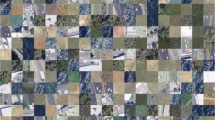Abstract
Satellite images act as windows to the world, providing us with detailed snapshots of Earth’s land surface. Utilizing various spectral bands, sensors aboard satellites detect and record information about different surface features, including vegetation, water bodies, urban areas, and barren land. By analyzing the spatial distribution and spectral characteristics of these features, scientists can classify and map land cover types with remarkable precision. The Landsat 8 satellites capture multispectral imagery with an image feature of 30 m for the optical spectrum, along with a thermal band at 100 m resolution. The revisit time for global coverage is approximately 16 days. The Sentinel program, operated by the ESA, includes multiple satellites such as S2 and S1. Sentinel-2 captures imagery at an analysis rate of 10 m for the optical spectrum, with repeatedly visiting in five days. S1 provides SAR data with an image analysis rate of 10–40 m, allowing imaging regardless of weather conditions or daylight. This paper proposes a deep learning model which will process different satellite imagery, i.e., a single DL model which process different satellite images for LULC identification. Here, the satellite images form S1, S2, and L8 for the year 2020 are processed using a single convolutional neural network model (CNN) for classification of LULC. Caatinga Forest Region, Brazil, was taken as the study area which includes three states Rio Grande Do Norte, Paraiba and Pernambuco. Deep neural networks are complex and powerful computational models inspired by the intricate structure and functionality of the human brain. These networks consist of multiple layers of interconnected artificial neurons, each performing its own calculation and contributing to the overall learning and decision-making process. Accuracy and Kappa analysis was done with each satellite images and combination of different satellite images using Google earth engine analysis. The detail study will boost the land cover classification task.
Access this chapter
Tax calculation will be finalised at checkout
Purchases are for personal use only
Similar content being viewed by others
References
Ienco D, Interdonato R, Gaetano R, Minh DHT (2019) Combining Sentinel-1 and Sentinel-2 satellite image time series for land cover mapping via a multi-source deep learning architecture ISPRS J Photogramm Rem Sens 158:11–22
Talukdar S, Singha P, Mahato S, Shahfahad, Pal S (2021) Land-use land-cover classification by machine learning classifiers for satellite observations—a review. Rem Sens 12:1135. https://doi.org/10.3390/rs12071135
Shafique A, Cao G, Khan Z, Asad M, Aslam M (2022) Deep learning based change detection in remote sensing 48 images: a review. Rem Sens 14:871
Helber P, Bischke B, Dengel A, Borth D (2017) Eurosat: a novel dataset and deep learning benchmark for land use and land cover classification. arXiv preprint arxiv:1709.00029
Leitloff J, Riese FM (2018) Examples for CNN training and classification on Sentinel-2 data. Zenodo, Geneve, Switzerland
Balaniuk R, Isupova O, Reece T (2020) Article mining and tailings dam detection in satellite imagery using deep learning. Sensors 20:6936. https://doi.org/10.3390/s20236936
Xu X, Li W, Ran Q, Du Q, Gao L, Zhang B (2017) Multisource remote sensing data classification based on convolutional neural network. IEEE Trans Geosci Rem Sens 56:937–949
Lei T, Zhang Y, Lv Z, Li S, Liu S, Nandi AK (2019) Landslide inventory mapping from bitemporal images using deep convolutional neural networks. IEEE Geosci Rem Sens Lett 2019(16):982–986
Bischke B, Helber P, Folz J, Borth D, Dengel A (2019) Multi-task learning for segmentation of building footprints with deep neural networks. In: Proceedings of the 2019 IEEE international conference on image processing (ICIP), Taipei, Taiwan, 22–25 Sept 2019, pp 1480–1484
Dong S, Zhuang Y, Yang Z, Pang L, Chen H, Long T (2020) Land cover classification from VHR optical remote sensing images by feature ensemble deep learning network. IEEE Geosci Rem Sens Lett 17(8)
Li H, Gong M, Zhang M, Wu Y (2021) Spatially self-paced convolutional networks for change detection in heterogeneous images. IEEE J Sel Top Appl Earth Obs Rem Sens 14:4966–4979
Yu Q (2014) Object-based detailed vegetation classification with airborne high spatial resolution remote sensing imagery. Photogramm Eng Rem Sens 72(7):799–811
Chughtai AH, Abbasi H, Karas IR (2021) A review on change detection method and accuracy assessment for land use land cover. Rem Sens Appl Soc Environ 22:100482
Maladkar K (2018) Overview of convolutional neural network in image classification. CNN Reference Jan 25, 2018. [Online]. Available https://www.analyticsindiamag.com/convolutionalneural-network-image-classification-overview/. Accessed 10th Feb 2019
Kerner HR, Wagstaff KL, Bue BD, Gray PC, Bell JF, Amor HB (2019) Toward generalized change detection on planetary surfaces with convolutional autoencoders and transfer learning. IEEE J Sel Top Appl Earth Obs Rem Sens 12:3900–3918
Sarker IH, Kayes ASM, Watters P (2019) Effectiveness analysis of machine learning classification models for predicting personalized context-aware smartphone usage. J Big Data 6(1):1–28
Deng L, Hinton G, Kingsbury B (2013) New types of deep neural network learning for speech recognition 2013, and related applications: an overview. In: Proceedings of IEEE international conference on acoustics, speech, and signal processing (ICASSP), pp 8599–8603
Mu L, Wang L, Wang Y, Chen X, Han W (2019) Urban land use and land cover change prediction via self-adaptive cellular based deep learning with multi sourced data. IEEE J Appl Earth Observ Rem Sens
Ma L, Liu Y, Zhang X, Ye Y, Yin G, Johnson BA (2019) Deep learning in remote sensing applications: a meta-analysis and review. ISPRS J Photogramm Rem Sens 152:166–177
Author information
Authors and Affiliations
Corresponding author
Editor information
Editors and Affiliations
Rights and permissions
Copyright information
© 2023 The Author(s), under exclusive license to Springer Nature Singapore Pte Ltd.
About this paper
Cite this paper
Babitha, M.S., Diana Andushia, A., Mehathab, A. (2023). A Unified Deep Learning Model for Multi-Satellite Image Classification of Land Use and Land Cover. In: Shakya, S., Tavares, J.M.R.S., Fernández-Caballero, A., Papakostas, G. (eds) Fourth International Conference on Image Processing and Capsule Networks. ICIPCN 2023. Lecture Notes in Networks and Systems, vol 798. Springer, Singapore. https://doi.org/10.1007/978-981-99-7093-3_31
Download citation
DOI: https://doi.org/10.1007/978-981-99-7093-3_31
Published:
Publisher Name: Springer, Singapore
Print ISBN: 978-981-99-7092-6
Online ISBN: 978-981-99-7093-3
eBook Packages: Intelligent Technologies and RoboticsIntelligent Technologies and Robotics (R0)




